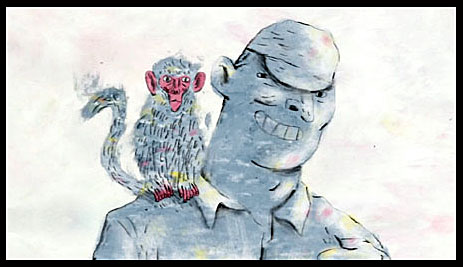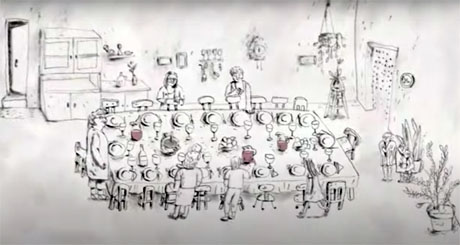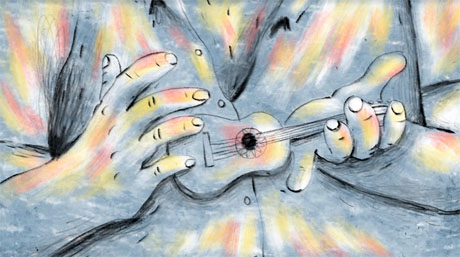
Laura Goncalves’ new documentary animated short film The Garbage Man is one of the 15 finalists for the 2023 Best Animated Short Film Oscar. Goncalves interviewed members of her family about her uncle Manuel, a unique man who had a major impact on her life. In this Animation Scoop Q&A, Goncalves shares how she was able to capture the spirit of her loved ones. (This interview was edited for length and clarity.)
Jackson Murphy: How does it feel to be on the Academy Awards shortlist?
Laura Goncalves: Awesome. It feels really good. It’s amazing to be one of the 15 shorts, side by side with such great people and films. It’s very good. I feel really honored that the film got this recognition, especially being Portuguese-spoken, which is something I really wanted to do. I wasn’t really sure how it was going to be received. I’m really happy that it got to this final list. It’s cool.

JM: It is a great, global year, with unique perspectives, including yours. I love the presence your uncle Manuel has with that picture on the wall with the monkey in your short. Tell me about using that as a starting point.
LG: The film is in my aunt’s house, where I always saw that picture. It was a very important picture to put everything together and bring all of the subjects together. We don’t speak about the war like we speak about other funny stories we had with him. But I thought it was important to speak about our background. There was a lot in common that my uncle went through that a lot of other people in Portugal also went through. It was important to talk about these times in history, like the big immigration of the ’60s and ’70s, before the revolution, the colonial war, where a lot of people died. There was so much ignorance and lack of knowledge. The war that we’re seeing now: there’s also a lot of that. The things that are going on are not known in all of the countries at the same time in the same means. Not everyone has the luck to have the knowledge and truth of what is going on in the world. In this period in Portugal, it was a lot like that.
People here were missing the people that were in the war, and they couldn’t talk to them because of the censorship. The portrait had to have a connection to the war. The monkey was a funny element. I only found out about this after I was making the film. A lot of people came to me and talked about the people they knew who went to war who also had a monkey. In the case of my uncle, I wanted to have it at the table as an element that was a bit funny and exuberant and exotic. My uncle was always very exotic. When I was a child, he would come once a year, and during that time that he was here in Portugal, everything would always be a party with the family being together. And then he went away again… it seemed like he was very sad. When he came back he was colorful. This is how I remember my uncle coming and going. I also wanted the monkey to have that kind of spirit, to personalize the personality he had. After being in a war… he became this character that just wants to live every day to the fullest and enjoy being with his family as much as he can. This portrait is a connection to the past.

JM: Your film really celebrates your uncle and families coming together to share a meal and share stories. I know you interviewed many of your family members for this, and we hear their audio. What was the process like of deciding which interview soundbites and clips you would and would not use — that editing?
LG: That was a process that kind of went from the beginning to the end. It was very important in the beginning. That was the first part of making the film. I did a series of interviews. Then I selected them to a soundtrack. I spent around a month in the village where I am now in Italy. Not a lot of people — completely isolated. I selected all of those hours and tried to create a narrative that would make sense. I built a soundtrack. And to this soundtrack, with all the voices I selected, I started making drawings — adding visuals. And I needed to go back and do more interviews. There were a few parts I had to fill in to understand certain things a little bit better, including the war and the illegal immigration. This was a very heavy subject for my aunt to talk about.
I showed the film to other people and got feedback. And there were also some sounds… and images to explain a situation. There are some silent parts. I had to let [the film] breathe a little bit. The conversation at the table was important. I interviewed my mom, my aunt and my cousin talking together. I did separate interviews but also some together to have answers to certain things. The sound design also worked with putting everything together, like everything is happening at the same place. I had all of these different recordings in different rooms with different echoes. That was completely crazy. (laughs) I’m happy with it. The most important thing was to get the genuine answers to everything and genuine stories they were telling.

JM: You did such an excellent job of putting it all together — and feeling so natural. We learn he was this garbage man. He found objects and revived them — saved some of them. What is the object you own you feel is very unique and kind of quirky, different and one of a kind? What piece stands out for you?
LG: A unique object? Oh my gosh. I never got that question before. (laughs) All of the things that are in the film are things I remember he brought. Instruments he used to play. The little accordion is something I remember very well. He was this huge guy with really huge fingers and he was playing this really tiny accordion. I have this picture in my mind of him doing it. It stayed with me, so it’s in the film. The guitar is also something very present. My cousins play music. They’re all very creative. I always saw guitars around the houses. He would bring them back. It’s always been an element. Toys in general. I remember those because it’s this image of this adult playing with toys that I have in my mind.
JM: I love that you took what you remember and put it in the film. And it really works! What would an Oscar nomination mean to you, to get to the 95th Academy Awards with this personal, excellent short?
LG: Well it would mean a lot because I’m not just bringing a film that I did. I’m bringing this personal story. I’m bringing my family. I’m bringing the voices of my family to a lot more people, which is what this means. To open the reach up a lot more for this kind of film. To watch a short film, it’s usually in a closed circle of people. To be nominated, it means the film will be reaching out to a [larger] amount of the public. And that would be amazing. The film would get seen by a lot more people. It would be great, and I think that’s what any of us doing our job want to do — any filmmaker — that our films get seen by as many people as possible, and to pass the message that we want to pass to as many people as we can.
- INTERVIEW: Jeff Fowler On “Knuckles” And “Sonic 3” - April 22, 2024
- INTERVIEW: “Inside Out 2” Director And Producer On Pixar Sequel - April 16, 2024
- INTERVIEW: “Puffin Rock And The New Friends” And 25 Years Of Cartoon Saloon - April 10, 2024


 January 11th, 2023
January 11th, 2023  Jackson Murphy
Jackson Murphy  Posted in
Posted in  Tags:
Tags: 






